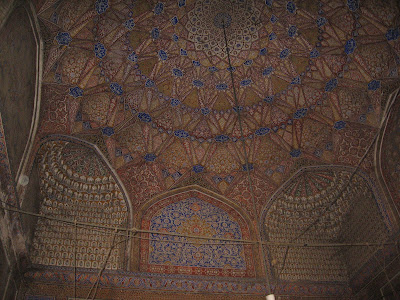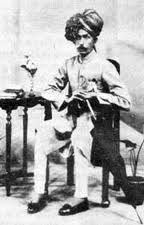February 15th - Inside the Walled City, Lahore:
Went with a friend on a walking tour inside the walled city ('androon shehr'). We entered via Masti Gate from the Minar-e-Pakistan / Badami Bagh side of Circular road and eventually exited from Delhi Gate after going through numerous alleyways and bazaars of the inner city. We stopped along the way to see some mosques and historic buildings and enjoyed a Kulcha/Chhole lunch at the stepped entrance of Sonehri Masjid.
 |
| The front courtyard and facade of Begum Shahi Mosque |
Entering Masti Gate our first stop was the oldest extant Mughal mosque in Lahore, the Maryam Zamani or Begum Shahi Mosque (above) built in 1614. This beautiful mosque close to the Akbari Gateway entrance of the Lahore Fort was built by Emperor Jahangir's mother who was known as Maryam-uz-zamani (Mary of her age). This wife of Emperor Akbar and mother of Jahangir was a Rajput princess, the daughter of Raja Bihari Mal of Amber (now Jaipur). She was born Rajkumari Hira Kunwari.
In her Lahore Travel Guide, Yasmeen Lari writes: "Comparatively small in size, its present exterior hardly provides the foretaste of the wealth of decoration in the prayer hall. ---The central dome rises above the remaining domes and is carried on a drum; while those on the flanking bays are rather flat hemispherical cupolas. The treatment of the enormous dome itself is remarkable in its
muqarnas (stalactite squinches) and elegantly painted fresco network."
 |
| The beautiful interior of the dome of Begum Shahi Mosque with its painted frescoes |
From the Begum Shahi mosque we stepped into the Masti Gate bazaar and walked south past the dense rows of shops toward Moti bazaar. Many of the bazaars inside the walled city tend to specialize in specific product categories interspersed with food shops. For example, Masti Gate and Moti Bazaar have dozens of footwear shops. Arriving at Chowk Surjan Singh from Moti bazaar we took a left turn onto Hatta bazaar. Continuing on Hatta bazaar we arrived at the junction of Shahalmi bazaar heading south and Dabbi bazaar heading east. At this junction slightly south east is the Kasaira (utensils) bazaar and hidden amongst shops full of shiny pots, pans and pressure cookers is a very narrow entrance to a hidden historic garden called Baoli Ranjit Singh Bagh. This now dilapidated garden once had a stepped well (
baoli) where people bathed in the summer months. The baoli marked the residence of Sikhism's fifth guru, Guru Arjun Dev (1563 - 1606). Yasmeen Lari informs us that "later, the well was filled with the debris of Guru Arjun's demolished house and lay uncared for many years. It was restored when an ailing Maharaja Ranjit Singh dreamt that he would recover only after he had taken a bath in the waters of the
baoli." The abandoned
bagh today with a few young kids playing cricket awaits a modern savior.
 |
| Baoli Ranjit Singh Bagh near the junction of Shahalmi and Dabbi Bazaars |
There are homes and buildings that surround the Baoli Ranjit Singh Bagh. Standing inside the garden I saw the fascinating facade of the building below ("Gobind Ram Kahan Chand, Estd. 1805, Hindustan Commercial Bank Ltd."). It was puzzling to me how this facade has survived in its current condition because it looks freshly restored. (A bit of Googling revealed that Gobind Ram Kahan Chand was the founder of a company in Lahore in 1805 focused on spreading Ayurveda and its benefits. The company moved to Delhi after partition and is still in business today as
GK Herbals.)
 |
| Facade of an old building visible from Baoli Ranjit SIngh Bagh |
Exiting the bagh we continued our walk east into Dabbi bazaar which is a shopping area popular with women of the walled city with its shops full of crockery, kitchenware and sewing and knitting supplies. It is from Dabbi bazaar near the Kashmiri bazaar chowk that one enters the famous, elevated Sonehri Masjid with its golden domes. This mid-18th century mosque was built by Nawab Bhikari Khan, Governor of Lahore during the time that Mir Mannu was the Mughal ruler of Punjab. Mir Mannu had defeated Ahmad Shah Durrani in 1748 in a battle in Sirhind and remained the Governor of Punjab until his death in 1753.
 |
| A view of Sonehri Masjid from the front entrance |
Sonehri Masjid was elevated above the shops in Dabbi bazaar with the intention that the rent from the shops below the mosque would provide a steady source of revenue for the mosque's maintenance. For a short while during the reign of Ranjit Singh, the mosque was shut down due to the complaints about disturbance caused by the azan by local Sikhs who had placed the Garanth Sahib in the adjacent
baoli mentioned above. The intervention by the Fakir family of Bhati Gate, who had good relations with Ranjit Singh, resulted in the Sikh ruler reversing his decision.
 |
| The streets of the walled city were decorated extensively for Eid Milad-un-Nabi (Prophet's birth anniversary) |
After enjoying an impromptu lunch from the street vendor at the entrance of Sonehri masjid we continued east through Kashmiri bazaar shops past Chowk Kotwali to the grand Masjid Wazir Khan. Perhaps the finest inner city mosque, Masjid Wazir Khan built in 1634 is an architectural and cultural treasure. It has been extensively photographed and is an oasis of calm in the midst of the bustling walled city. Flocks of pigeons perched on the domes and minarets of the mosque frequently fly over the courtyard from one side of the mosque to the other creating a surreally beautiful environment with the sound of their fluttering wings. Most of the surrounding buildings looking onto the mosque courtyard are residential and fit in seamlessly with the mosque's architecture unlike some other parts of the walled city where ugly new developments sometimes sit in jarring conflict next to sublime monuments.
 |
| Entrance gateway and minarets of Wazir Khan mosque as viewed from outside the prayer area entrance |
Hakim Aliuddin, the trusted aide of Emperor Shahjahan was granted the title of Wazir Khan in 1620. He became the governor of Punjab in 1632 and left a legacy of numerous monuments, the most famous of which is the Wazir Khan mosque. He also established the town of Wazirabad located 100 km north of Lahore in Gujranwala district.
 |
| Single aisle prayer chamber of Masjid Wazir Khan |
After spending some time in the peaceful Wazir Khan mosque we walked south east past the Delhi gate bazaar exiting the walled city via Delhi gate where our car was waiting to transport us back home to a more spacious, amenity-filled but less enchanting Lahore.
To Follow:
Part 3 - Shahdara Monuments
Part 4 - A Visit to Multan
Part 5 - Snapshots of Personal History
